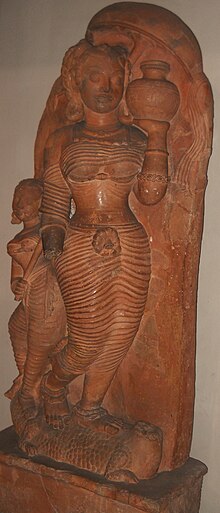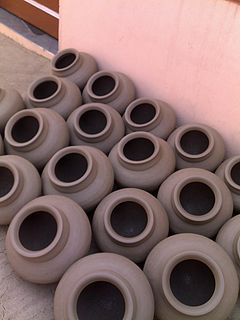For other uses, see Kumbha (disambiguation). Fictional character
| Kumbha | |
|---|---|
 The goddess Ganga shown with a kumbha (a full vase) The goddess Ganga shown with a kumbha (a full vase) |
A kumbha (Sanskrit: कुम्भ) is a type of pottery in India. Traditionally, it is made by Kumbhars, also known as Prajapatis.
In the context of Hindu, Jain and Buddhist mythology, the kumbha symbolises the womb. It represents fertility, life, generative power of human beings and sustenance and is generally associated with devis, particularly Ganga.
Mythological origin
According to Hindu mythology, the first kumbha was created by Prajapati on the occasion of the marriage of Shiva, so he was first kumbhara "potter". Another myth says that the first pot was created by Vishvakarman on the occasion of the churning of the ocean for the first Amrit Sanchar.
In Hindu mythology and scriptures, several references are found of human beings born from kumbha. A legend states that rishi Agastya was born out of a kumbha.

In several religious ceremonies and rituals, kumbhas or kalashas filled with water and leaves and decorated with intricate motifs, sometimes with ornaments, play an important role in ancient India. These rituals still survive in India.
In Hindu astrology, the kumbha stands for the zodiac sign Aquarius and is ruled by 2 important planets that is (Saturn and Rahu). Kumbha is also associated with the Kumbha Mela, which happens when the planet Brihaspati moves into Aquarius.
In Hindu epic Ramayana, Ravana's brother Kumbhakarna had a son named Kumbha, who was killed by Sugriva.
With time professions turned in to last names e.g. the last name Kumbha refers to one of the surnames of Schedule tribe Community named Yerukala in Andhra Pradesh.
See also
- Kumbha rashi, name of zodiac sign Aquarius in sanskrit
- Kumbha Mela
- Kalasha
- Matki (earthen pot)
- Bumpa, a Tibetan Buddhist pot
References
- Darian 2001, p. 125 Quote: The Kumbha: After the Makara, Ganga's most distinctive sculptural feature is the full vase, first appearing with the river goddess on the same Varaha cave frieze from Udaygiri. Although not common in the early stages of the Ganga image, the full vase appears more and more frequently as the Ganga theme reaches maturity.
- The Tribes and Castes of the Central Provinces of India, Volume 4 by R. V. Russell
- General
- Darian, Steven (2001), The Ganges in myth and history, Delhi:Motilal Banarasidass. Pp. xviii, 219. Originally published in 1978 by The University of Hawaii Press, Honolulu., ISBN 81-208-1757-5
- Dictionary of Hindu Lore and Legend (ISBN 0-500-51088-1) by Anna Dallapiccola
| Hindu deities and texts | ||
|---|---|---|
| Gods |  | |
| Goddesses | ||
| Other deities | ||
| Texts (list) | ||
This article about the culture of India is a stub. You can help Misplaced Pages by expanding it. |
This Hindu mythology–related article is a stub. You can help Misplaced Pages by expanding it. |